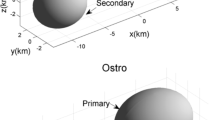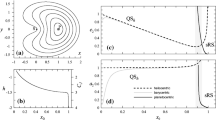Abstract
Periodic orbits are crucial in facilitating the understanding of the dynamical behavior of elongated asteroids. As a specific type of periodic orbit, resonant orbits can enrich the orbit design method of deep-space exploration missions. Herein, a dipole segment model for investigating the orbital dynamics of elongated asteroids is briefly introduced. A new numerical algorithm named the modified path searching method for identifying spin-orbit resonant orbits is proposed. Using the modified path searching and pseudo-arclength continuation methods, four spin-orbit resonant families for asteroid 2063 Bacchus are obtained. The distribution of eigenvalues and stability curves for the four resonant families are presented. In particular, some critical points corresponding to period-doubling and tangent bifurcations appear in the stability curves.

Similar content being viewed by others
References
Sanchez, J. P., McInnes, C. R. Assessment on the feasibility of future shepherding of asteroid resources. Acta Astronautica, 2012, 73: 49–66.
Shustov, B. M., Naroenkov, S. A., Efremova, E. V. On population of hazardous celestial bodies in the near-Earth space. Solar System Research, 2017, 51(1): 38–43.
Roll, R., Witte, L., Arnold, W. ROSETTA lander Philae — soil strength analysis. Icarus, 2016, 280: 359–365.
Prockter, L., Murchie, S., Cheng, A., Krimigis, S., Farquhar, R., Santo, A., Trombka, J. The NEAR shoemaker mission to asteroid 433 Eros. Acta Astronautica, 2002, 51(1–9): 491–500.
NASA. NASA selects two missions to explore the early solar system. Defense & Aerospace Week, 2017. Available at https://www.nasa.gov/press-release/nasa-selects-two-missions-to-explore-the-early-solar-system.
Jin, W. T., Li, F., Yan, J. G., Andert, T. P., Ye, M., Yang, X., Hao, W. F., Barriot, J. P. A simulated global GM estimate of the asteroid 469219 Kamo‘oalewa for China’s future asteroid mission. Monthly Notices of the Royal Astronomical Society, 2020, 493(3): 4012–4021.
Werner, R. A. The gravitational potential of a homogeneous polyhedron or don’t cut corners. Celestial Mechanics and Dynamical Astronomy, 1994, 59(3): 253–278.
Werner, R. A., Scheeres, D. J. Exterior gravitation of a polyhedron derived and compared with harmonic and mascon gravitation representations of asteroid 4769 Castalia. Celestial Mechanics and Dynamical Astronomy, 1996, 65(3): 313–344.
Kaula, W. M., Street, R. E. Theory of satellite geodesy: Applications of satellites to geodesy. Physics Today, 1967, 20(10): 101.
Geissler, P., Petit, J. M., Durda, D. D., Greenberg, R., Bottke, W., Nolan, M., Moore, J. Erosion and ejecta reaccretion on 243 Ida and its moon. Icarus, 1996, 120(1): 140–157.
Bartczak, P., Breiter, S., Jusiel, P. Ellipsoids, material points and material segments. Celestial Mechanics and Dynamical Astronomy, 2006, 96(1): 31–48.
Najid, N. E., Elourabi, E. H., Zegoumou, M. Potential generated by a massive inhomogeneous straight segment. Research in Astronomy and Astrophysics, 2011, 11(3): 345–352.
Chermnykh, S. Stability of libration points in a gravitational field. Leningradskii Universitet Vestnik Matematika Mekhanika Astronomiia, 1987, 2(8): 73–77.
Zeng, X. Y., Jiang, F. H., Li, J. F., Baoyin, H. X. Study on the connection between the rotating mass dipole and natural elongated bodies. Astrophysics and Space Science, 2015, 356(1): 29–42.
Li, X. Y., Gao, A., Qiao, D. Periodic orbits, manifolds and heteroclinic connections in the gravity field of a rotating homogeneous dumbbell-shaped body. Astrophysics and Space Science, 2017, 362(4): 85.
Li, X. Y., Qiao, D., Cui, P. Y. The equilibria and periodic orbits around a dumbbell-shaped body. Astrophysics and Space Science, 2013, 348(2): 417–426.
Zeng, X. Y., Zhang, Y. L., Yu, Y., Liu, X. D. The dipole segment model for axisymmetrical elongated asteroids. The Astronomical Journal, 2018, 155(2): 85.
Feng, F., Tang, L. N., Xu, J. F., Liu, H., Liu, Y. W. A review of the end-effector of large space manipulator with capabilities of misalignment tolerance and soft capture. Science China Technological Sciences, 2016, 59(11): 1621–1638.
Hu, W. D., Scheeres, D. J. Periodic orbits in rotating second degree and order gravity fields. Chinese Journal of Astronomy and Astrophysics, 2008, 8(1): 108–118.
Jiang, Y., Yu, Y., Baoyin, H. X. Topological classifications and bifurcations of periodic orbits in the potential field of highly irregular-shaped celestial bodies. Nonlinear Dynamics, 2015, 81(1–2): 119–140.
Broucke, R., Elipe, A. The dynamics of orbits in a potential field of a solid circular ring. Regular & Chaotic Dynamics, 2005, 10(2): 129–143.
Zhang, Y. L., Zeng, X. Y., Liu, X. D. Study on periodic orbits around the dipole segment model for dumbbell-shaped asteroids. Science China Technological Sciences, 2018, 61(6): 819–829.
Blesa, F. Periodic orbits around simple shaped bodies. Monografías del Seminario Matemático García de Galdeano, 2006, 33: 67–74.
Liu, X. D., Baoyin, H. X., Ma, X. R. Periodic orbits in the gravity field of a fixed homogeneous cube. Astrophysics and Space Science, 2011, 334(2): 357–364.
Ellis, K. M., Murray, C. D. The disturbing function in solar system dynamics. Icarus, 2000, 147(1): 129–144.
Vaquero, M., Howell, K. C. Transfer design exploiting resonant orbits and manifolds in the Saturn-titan system. Journal of Spacecraft and Rockets, 2013, 50(5): 1069–1085.
Fischer, D. A., Marcy, G. W., Butler, R. P., Vogt, S. S., Laughlin, G., Henry, G. W., Abouav, D., Peek, K. M. G., Wright, J. T., Johnson, J. A., et al. Five planets orbiting 55 Cancri. The Astrophysical Journal Letters, 2008, 675(1): 790–801.
Ji, J. H., Kinoshita, H., Liu, L., Li, G. Y. Could the 55 Cancri planetary system really be in the 3:1 mean motion resonance? The Astrophysical Journal Letters, 2003, 585(2): L139–L142.
Liu, L. B., Qian, Y. J., Yang, X. D. Initial parameter analysis about resonant orbits in Earth-Moon system. Advances in Astronomy, 2019, 2019: 6324901.
Tan, M. H., Zhang, K., Lv, M. B., Xing, C. Transfer to long term distant retrograde orbits around the Moon. Acta Astronautica, 2014, 98: 50–63.
Feng, J. L., Hou, X. Y. Dynamics of equilibrium points in a uniformly rotating second-order and degree gravitational field. The Astronomical Journal, 2017, 154(1): 21.
Borderes-Motta, G., Winter, O. C. Poincaré surfaces of section around a 3D irregular body: The case of asteroid 4179 Toutatis. Monthly Notices of the Royal Astronomical Society, 2017, 474(2): 2452–2466.
Lara, M., Peláez, J. On the numerical continuation of periodic orbits. Astronomy & Astrophysics, 2002, 389(2): 692–701.
Yu, Y., Baoyin, H. X. Generating families of 3D periodic orbits about asteroids. Monthly Notices of the Royal Astronomical Society, 2012, 427(1): 872–881.
Zeng, X. Y., Liu, X. D. Searching for time optimal periodic orbits near irregularly shaped asteroids by using an indirect method. IEEE Transactions on Aerospace and Electronic Systems, 2017, 53(3): 1221–1229.
Sanchez, J. P., McInnes, C. R. Assessment on the feasibility of future shepherding of asteroid resources. Acta Astronautica, 2012, 73: 49–66.
Jiang, Y. Equilibrium points and periodic orbits in the vicinity of asteroids with an application to 216 Kleopatra. Earth, Moon, and Planets, 2015, 115(1–4): 31–44.
Acknowledgements
This study was supported partially by the National Natural Science Foundation of China (Grant Nos. 11772009 and 12172013) and the Beijing Municipal Natural Science Foundation (Grant No. 1192002).
Author information
Authors and Affiliations
Corresponding author
Additional information
Declaration of competing interest
The authors have no competing interests to declare that are relevant to the content of this article.
Yu-Hang Zhang is a master student in Beijing University of Technology. He received his bachelor degree in industry design from North China Institute of Aerospace Engineering in 2018. His current research interest is astrodynamics. E-mail: 1411506497@qq.com.
Ying-Jing Qian is current an associate professor in Beijing University of Technology. She received her Ph.D. degree in aeronautical and astronautical science and technology from Harbin Institute of Technology, China, in 2013, and was a visiting scholar of Purdue University in 2010–2011. Her research interests are astrodynamics and interplanetary trajectory design. E-mail: candiceqyj@163.com
Xu Li is a master student in Beijing University of Technology. He received his bachelor degree in Beijing University of Technology in 2018. His current research interest is astrodynamics. E-mail: 18401658575@163.com.
Xiao-Dong Yang is the Distinguished Professor of dynamics and control in Beijing University of Technology. He received his Ph.D. degree in mechanics from Shanghai University, China, in 2004, and was a visiting scholar of Wilfred Laurier University in 2005–2006. His area of expertise is nonlinear vibrations and gyroscopic dynamics. E-mail: jxdyang@163.com.
Rights and permissions
About this article
Cite this article
Zhang, YH., Qian, YJ., Li, X. et al. Resonant orbit search and stability analysis for elongated asteroids. Astrodyn 7, 51–67 (2023). https://doi.org/10.1007/s42064-022-0132-6
Received:
Accepted:
Published:
Issue Date:
DOI: https://doi.org/10.1007/s42064-022-0132-6




